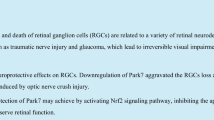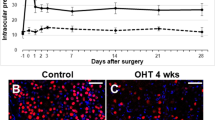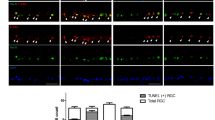Abstract
In the present study, we studied the factors that contribute to the injury-resistant property of melanopsin-expressing retinal ganglion cells (mRGCs). Since phosphatidylinositol-3 kinase (PI3 K)/Akt signaling pathway is one of the well-known pathways for neuronal cell survival, we investigated the survival of mRGCs by applying the PI3 K/Akt specific inhibitors after injury. Two injury models, unilateral optic nerve transection and ocular hypertension, were adopted using Sprague-Dawley rats. Inhibitors of PI3 K/Akt were injected intravitreally following injuries to inhibit the PI3 K/Akt signaling pathway. Retinas were dissected after designated survival time, immunohistochemistry was carried out to visualize the mRGCs using melanopsin antibody and the number of mRGCs was counted. Co-expression of melanopsin and phospho-Akt (pAkt) was also examined. Compared to the survival of non-melanopsin-expressing RGCs, mRGCs showed a marked resistance to injury and co-expressed pAkt. Application of PI3 K/Akt inhibitors decreased the survival of mRGCs after injury. Our previous study has shown that mRGC are less susceptible to injury following the induction of ocular hypertension. In this study, we report that mRGCs were injury-resistant to a more severe type of injury, the optic nerve transection. More importantly, the PI3 K/Akt pathway was found to play a role in maintaining the survival of mRGCs after injury.







Similar content being viewed by others
References
Berkelaar M, Clarke DB, Wang YC, Bray GM, Aguayo AJ (1994) Axotomy results in delayed death and apoptosis of retinal ganglion cells in adult rats. J Neurosci 14:4368–4374
Berson DM (2003) Strange vision: ganglion cells as circadian photoreceptors. Trends Neurosci 26:314–320
Bonnet D, Garcia M, Vecino E, Lorentz JG, Sahel J, Hicks D (2004) Brain-derived neurotrophic factor signalling in adult pig retinal ganglion cell neurite regeneration in vitro. Brain Res 1007:142–151
Cardone MH, Roy N, Stennicke HR, Salvesen GS, Franke TF, Stanbridge E, Frisch S, Reed JC (1998) Regulation of cell death protease caspase-9 by phosphorylation. Science 282:1318–1321
Caroni P, Schwab ME (1993) Oligodendrocyte- and myelin-associated inhibitors of neurite growth in the adult nervous system. Adv Neurol 61:175–179
Chauhan BC, Pan J, Archibald ML, LeVatte TL, Kelly ME, Tremblay F (2002) Effect of intraocular pressure on optic disc topography, electroretinography, and axonal loss in a chronic pressure-induced rat model of optic nerve damage. Invest Ophthalmol Vis Sci 43:2969–2976
Chen DF, Jhaveri S, Schneider GE (1995) Intrinsic changes in developing retinal neurons result in regenerative failure of their axons. Proc Natl Acad Sci USA 92:7287–7291
Cheng L, Sapieha P, Kittlerova P, Hauswirth WW, Di PA (2002) TrkB gene transfer protects retinal ganglion cells from axotomy-induced death in vivo. J Neurosci 22:3977–3986
Cheung ZH, Chan YM, Siu FK, Yip HK, Wu W, Leung MC, So KF (2004) Regulation of caspase activation in axotomized retinal ganglion cells. Mol Cell Neurosci 25:383–393
Datta SR, Brunet A, Greenberg ME (1999) Cellular survival: a play in three Akts. Genes Dev 13:2905–2927
Ferby IM, Waga I, Sakanaka C, Kume K, Shimizu T (1994) Wortmannin inhibits mitogen-activated protein kinase activation induced by platelet-activating factor in guinea pig neutrophils. J Biol Chem 269:30485–30488
Ferby I, Waga I, Kume K, Sakanaka C, Shimizu T (1996) PAF-induced MAPK activation is inhibited by wortmannin in neutrophils and macrophages. Adv Exp Med Biol 416:321–326
Grozdanic SD, Betts DM, Sakaguchi DS, Kwon YH, Kardon RH, Sonea IM (2003) Temporary elevation of the intraocular pressure by cauterization of vortex and episcleral veins in rats causes functional deficits in the retina and optic nerve. Exp Eye Res 77:27–33
Hannibal J, Hindersson P, Ostergaard J, Georg B, Heegaard S, Larsen PJ, Fahrenkrug J (2004) Melanopsin is expressed in PACAP-containing retinal ganglion cells of the human retinohypothalamic tract. Invest Ophthalmol Vis Sci 45:4202–4209
Hattar S, Liao HW, Takao M, Berson DM, Yau KW (2002) Melanopsin-containing retinal ganglion cells: architecture, projections, and intrinsic photosensitivity. Science 295:1065–1070
Huang Y, Cen LP, Luo JM, Wang N, Zhang MZ, van Rooijen N, Pang CP, Cui Q (2008) Differential roles of phosphatidylinositol 3-kinase/akt pathway in retinal ganglion cell survival in rats with or without acute ocular hypertension. Neuroscience 153:214–225
Jakobs TC, Libby RT, Ben Y, John SW, Masland RH (2005) Retinal ganglion cell degeneration is topological but not cell type specific in DBA/2 J mice. J Cell Biol 171:313–325
Ji JZ, Elyaman W, Yip HK, Lee VW, Yick LW, Hugon J, So KF (2004) CNTF promotes survival of retinal ganglion cells after induction of ocular hypertension in rats: the possible involvement of STAT3 pathway. Eur J NeuroSci 19:265–272
Ji J, Chang P, Pennesi ME, Yang Z, Zhang J, Li D, Wu SM, Gross RL (2005) Effects of elevated intraocular pressure on mouse retinal ganglion cells. Vision Res 45:169–179
Kaplan DR, Miller FD (1997) Signal transduction by the neurotrophin receptors. Curr Opin Cell Biol 9:213–221
Kermer P, Klocker N, Labes M, Bahr M (2000) Insulin-like growth factor-I protects axotomized rat retinal ganglion cells from secondary death via PI3-K-dependent Akt phosphorylation and inhibition of caspase-3 In vivo. J Neurosci 20:2–8
Kilic U, Kilic E, Soliz J, Bassetti CI, Gassmann M, Hermann DM (2005) Erythropoietin protects from axotomy-induced degeneration of retinal ganglion cells by activating ERK-1/-2. FASEB J 19:249–251
Kim HS, Park CK (2005) Retinal ganglion cell death is delayed by activation of retinal intrinsic cell survival program. Brain Res 1057:17–28
Kretz A, Happold CJ, Marticke JK, Isenmann S (2005) Erythropoietin promotes regeneration of adult CNS neurons via Jak2/Stat3 and PI3 K/AKT pathway activation. Mol Cell Neurosci 29:569–579
Li RS, Chen BY, Tay DK, Chan HH, Pu ML, So KF (2006a) Melanopsin-expressing retinal ganglion cells are more injury-resistant in a chronic ocular hypertension model. Invest Ophthalmol Vis Sci 47:2951–2958
Li RS, Tay DK, Chan HH, So KF (2006b) Changes of retinal functions following the induction of ocular hypertension in rats using argon laser photocoagulation. Clin Experiment Ophthalmol 34:575–583
Mittag TW, Danias J, Pohorenec G, Yuan HM, Burakgazi E, Chalmers-Redman R, Podos SM, Tatton WG (2000) Retinal damage after 3 to 4 months of elevated intraocular pressure in a rat glaucoma model. Invest Ophthalmol Vis Sci 41:3451–3459
Nakazawa T, Tamai M, Mori N (2002) Brain-derived neurotrophic factor prevents axotomized retinal ganglion cell death through MAPK and PI3 K signaling pathways. Invest Ophthalmol Vis Sci 43:3319–3326
Nakazawa T, Shimura M, Tomita H, Akiyama H, Yoshioka Y, Kudou H, Tamai M (2003) Intrinsic activation of PI3 K/Akt signaling pathway and its neuroprotective effect against retinal injury. Curr Eye Res 26:55–63
Park K, Luo JM, Hisheh S, Harvey AR, Cui Q (2004) Cellular mechanisms associated with spontaneous and ciliary neurotrophic factor-cAMP-induced survival and axonal regeneration of adult retinal ganglion cells. J Neurosci 24:10806–10815
Provencio I, Rodriguez IR, Jiang G, Hayes WP, Moreira EF, Rollag MD (2000) A novel human opsin in the inner retina. J Neurosci 20:600–605
Robinson GA, Madison RD (2004) Axotomized mouse retinal ganglion cells containing melanopsin show enhanced survival, but not enhanced axon regrowth into a peripheral nerve graft. Vision Res 44:2667–2674
Schwab ME, Kapfhammer JP, Bandtlow CE (1993) Inhibitors of neurite growth. Annu Rev Neurosci 16:565–595
Villegas-Perez MP, Vidal-Sanz M, Rasminsky M, Bray GM, Aguayo AJ (1993) Rapid and protracted phases of retinal ganglion cell loss follow axotomy in the optic nerve of adult rats. J Neurobiol 24:23–36
Weishaupt JH, Rohde G, Polking E, Siren AL, Ehrenreich H, Bahr M (2004) Effect of erythropoietin axotomy-induced apoptosis in rat retinal ganglion cells. Invest Ophthalmol Vis Sci 45:1514–1522
Yano S, Tokumitsu H, Soderling TR (1998) Calcium promotes cell survival through CaM-K kinase activation of the protein-kinase-B pathway. Nature 396:584–587
Zhou H, Li XM, Meinkoth J, Pittman RN (2000) Akt regulates cell survival and apoptosis at a postmitochondrial level. J Cell Biol 151:483–494
Acknowledgments
We would like to thank Mr. Tak-Ho Chu and Dr. Bing Hu for their stimulating discussion and comment on the manuscript. Our study was supported by the donations from the Hong Kong Charitable Foundation, and Ms. Annie Tsao Wen Wei and the Competitive Earmarked Research Grant (BQ-867) of The Hong Kong Polytechnic University.
Author information
Authors and Affiliations
Corresponding author
Rights and permissions
About this article
Cite this article
Li, SY., Yau, SY., Chen, BY. et al. Enhanced Survival of Melanopsin-expressing Retinal Ganglion Cells After Injury is Associated with the PI3 K/Akt Pathway. Cell Mol Neurobiol 28, 1095–1107 (2008). https://doi.org/10.1007/s10571-008-9286-x
Received:
Accepted:
Published:
Issue Date:
DOI: https://doi.org/10.1007/s10571-008-9286-x




